Asia-Pacific Trade Agreement (APTA): Analysis
VerifiedAdded on 2020/05/16
|15
|2656
|455
AI Summary
This assignment analyzes the effects of the Asia-Pacific Trade Agreement (APTA) on participating economies. It examines trade patterns and trends, specifically focusing on major players like China, India, and ROK, as well as developing nations such as Bangladesh, Lao PDR, and Sri Lanka. The analysis considers the impact of APTA on intra-regional trade, tariff concessions, and overall economic growth within the Asia-Pacific region.
Contribute Materials
Your contribution can guide someone’s learning journey. Share your
documents today.
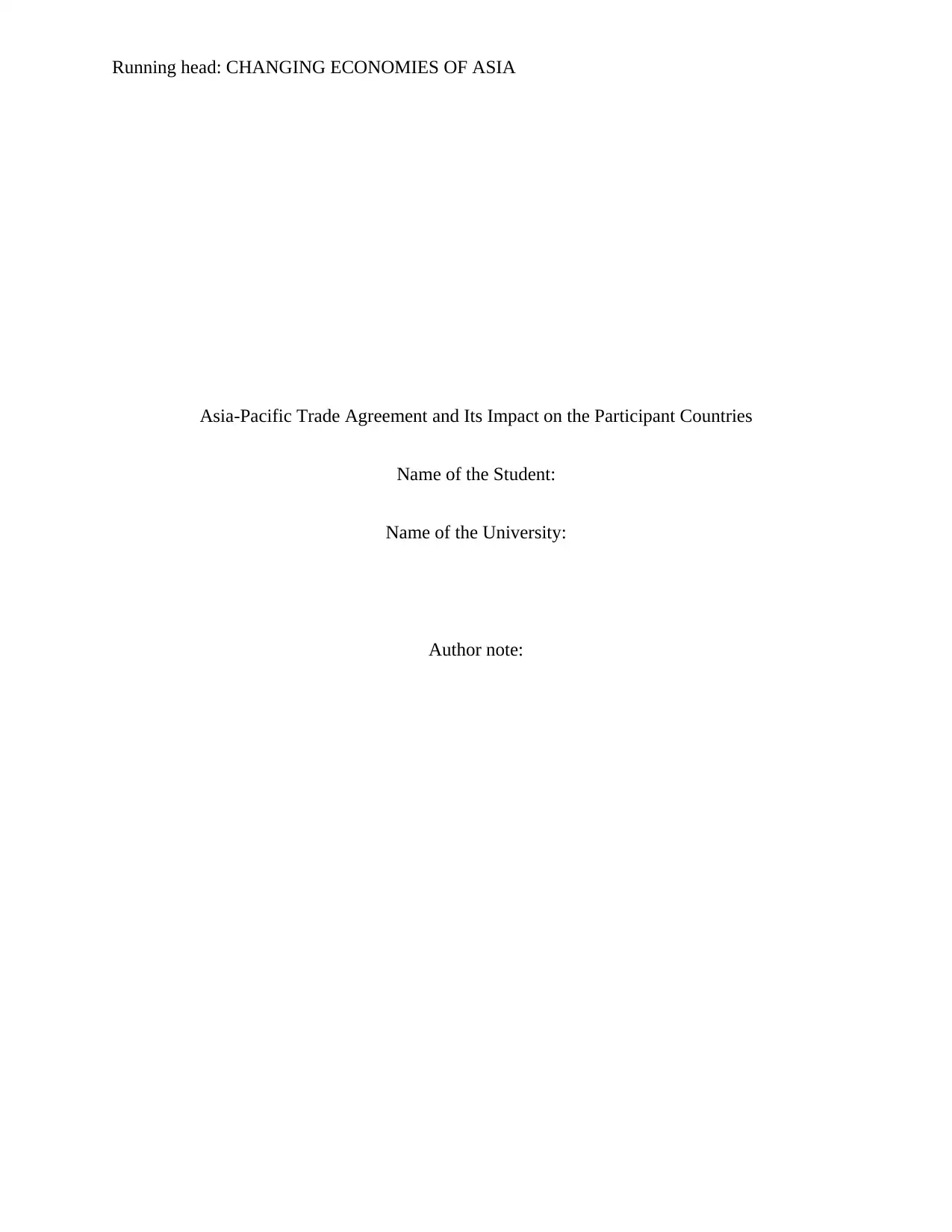
Running head: CHANGING ECONOMIES OF ASIA
Asia-Pacific Trade Agreement and Its Impact on the Participant Countries
Name of the Student:
Name of the University:
Author note:
Asia-Pacific Trade Agreement and Its Impact on the Participant Countries
Name of the Student:
Name of the University:
Author note:
Secure Best Marks with AI Grader
Need help grading? Try our AI Grader for instant feedback on your assignments.
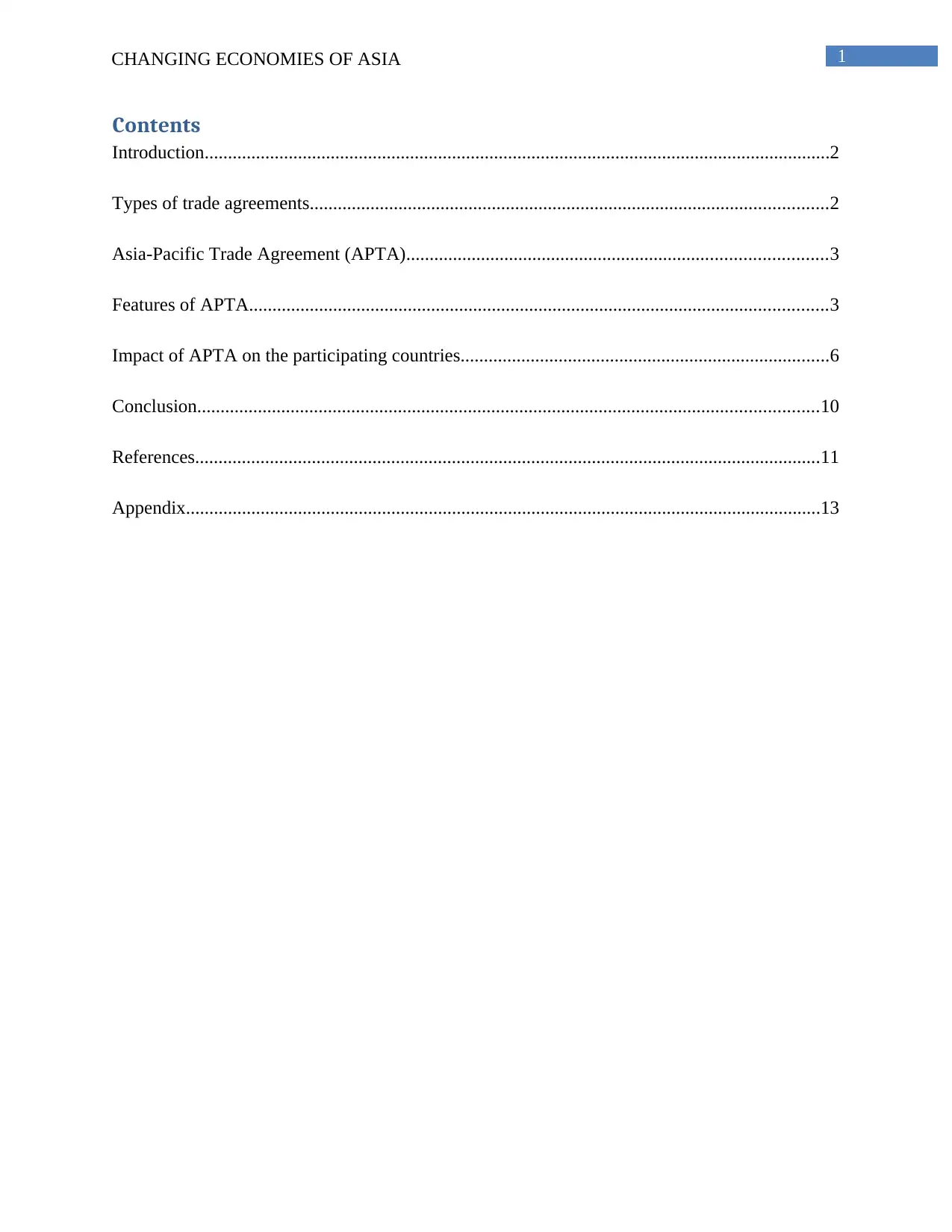
1CHANGING ECONOMIES OF ASIA
Contents
Introduction......................................................................................................................................2
Types of trade agreements...............................................................................................................2
Asia-Pacific Trade Agreement (APTA)..........................................................................................3
Features of APTA............................................................................................................................3
Impact of APTA on the participating countries...............................................................................6
Conclusion.....................................................................................................................................10
References......................................................................................................................................11
Appendix........................................................................................................................................13
Contents
Introduction......................................................................................................................................2
Types of trade agreements...............................................................................................................2
Asia-Pacific Trade Agreement (APTA)..........................................................................................3
Features of APTA............................................................................................................................3
Impact of APTA on the participating countries...............................................................................6
Conclusion.....................................................................................................................................10
References......................................................................................................................................11
Appendix........................................................................................................................................13

2CHANGING ECONOMIES OF ASIA
Introduction
The development of the Asian countries is majorly accredited to the regional trade
agreements that exist among the developing countries of Asia. The Asian countries constitute
half of the production and consumption market of the world and the regional trade agreements
play a crucial role in achieving economic growth and stability of the region1. The participant
countries have majorly benefitted from the regional trade agreements in the field of economic
relations, development, trade, services, investment, industry and overall social welfare.
Types of trade agreements
Regional trade agreements are reciprocal formal trade agreements or relationship between
two or than two countries. Various types of trade agreements exist in the international economy
depending on the level of cooperation among the partners, such as, Free Trade Agreement
(FTA), Preferential Trade Agreements (PTA), Regional trade Agreements (RTA), Custom
unions, Common markets etc. Under FTA, the member nations agree to eliminate or decrease
tariffs and non tariff barriers to increase trade volume. Under PTA, the members agree to reduce
the tariffs on the agreed number of the tariff lines or list. RTA is a type of PTA which mainly
focuses on a particular region. The biggest example of common market is the single market for
EU. This is a single market that offers products to member countries at a lower rate. Custom
Union is a trade bloc, composed of free trade area and a common external tariff. Participant
nations establish common policy for external trade.
1 Kawai, Masahiro, and Ganeshan Wignaraja. 2013. "Patterns of free trade areas in Asia."
Introduction
The development of the Asian countries is majorly accredited to the regional trade
agreements that exist among the developing countries of Asia. The Asian countries constitute
half of the production and consumption market of the world and the regional trade agreements
play a crucial role in achieving economic growth and stability of the region1. The participant
countries have majorly benefitted from the regional trade agreements in the field of economic
relations, development, trade, services, investment, industry and overall social welfare.
Types of trade agreements
Regional trade agreements are reciprocal formal trade agreements or relationship between
two or than two countries. Various types of trade agreements exist in the international economy
depending on the level of cooperation among the partners, such as, Free Trade Agreement
(FTA), Preferential Trade Agreements (PTA), Regional trade Agreements (RTA), Custom
unions, Common markets etc. Under FTA, the member nations agree to eliminate or decrease
tariffs and non tariff barriers to increase trade volume. Under PTA, the members agree to reduce
the tariffs on the agreed number of the tariff lines or list. RTA is a type of PTA which mainly
focuses on a particular region. The biggest example of common market is the single market for
EU. This is a single market that offers products to member countries at a lower rate. Custom
Union is a trade bloc, composed of free trade area and a common external tariff. Participant
nations establish common policy for external trade.
1 Kawai, Masahiro, and Ganeshan Wignaraja. 2013. "Patterns of free trade areas in Asia."
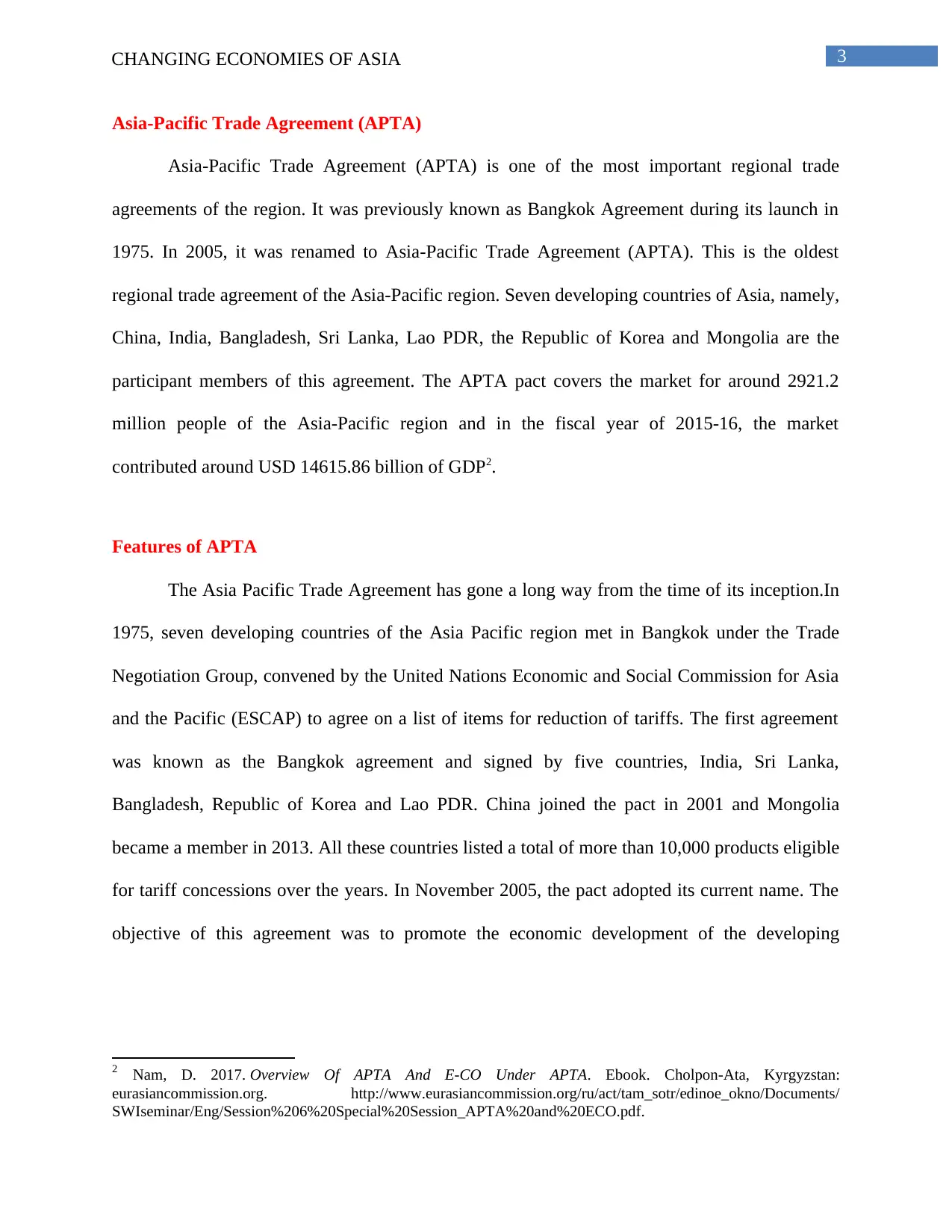
3CHANGING ECONOMIES OF ASIA
Asia-Pacific Trade Agreement (APTA)
Asia-Pacific Trade Agreement (APTA) is one of the most important regional trade
agreements of the region. It was previously known as Bangkok Agreement during its launch in
1975. In 2005, it was renamed to Asia-Pacific Trade Agreement (APTA). This is the oldest
regional trade agreement of the Asia-Pacific region. Seven developing countries of Asia, namely,
China, India, Bangladesh, Sri Lanka, Lao PDR, the Republic of Korea and Mongolia are the
participant members of this agreement. The APTA pact covers the market for around 2921.2
million people of the Asia-Pacific region and in the fiscal year of 2015-16, the market
contributed around USD 14615.86 billion of GDP2.
Features of APTA
The Asia Pacific Trade Agreement has gone a long way from the time of its inception.In
1975, seven developing countries of the Asia Pacific region met in Bangkok under the Trade
Negotiation Group, convened by the United Nations Economic and Social Commission for Asia
and the Pacific (ESCAP) to agree on a list of items for reduction of tariffs. The first agreement
was known as the Bangkok agreement and signed by five countries, India, Sri Lanka,
Bangladesh, Republic of Korea and Lao PDR. China joined the pact in 2001 and Mongolia
became a member in 2013. All these countries listed a total of more than 10,000 products eligible
for tariff concessions over the years. In November 2005, the pact adopted its current name. The
objective of this agreement was to promote the economic development of the developing
2 Nam, D. 2017. Overview Of APTA And E-CO Under APTA. Ebook. Cholpon-Ata, Kyrgyzstan:
eurasiancommission.org. http://www.eurasiancommission.org/ru/act/tam_sotr/edinoe_okno/Documents/
SWIseminar/Eng/Session%206%20Special%20Session_APTA%20and%20ECO.pdf.
Asia-Pacific Trade Agreement (APTA)
Asia-Pacific Trade Agreement (APTA) is one of the most important regional trade
agreements of the region. It was previously known as Bangkok Agreement during its launch in
1975. In 2005, it was renamed to Asia-Pacific Trade Agreement (APTA). This is the oldest
regional trade agreement of the Asia-Pacific region. Seven developing countries of Asia, namely,
China, India, Bangladesh, Sri Lanka, Lao PDR, the Republic of Korea and Mongolia are the
participant members of this agreement. The APTA pact covers the market for around 2921.2
million people of the Asia-Pacific region and in the fiscal year of 2015-16, the market
contributed around USD 14615.86 billion of GDP2.
Features of APTA
The Asia Pacific Trade Agreement has gone a long way from the time of its inception.In
1975, seven developing countries of the Asia Pacific region met in Bangkok under the Trade
Negotiation Group, convened by the United Nations Economic and Social Commission for Asia
and the Pacific (ESCAP) to agree on a list of items for reduction of tariffs. The first agreement
was known as the Bangkok agreement and signed by five countries, India, Sri Lanka,
Bangladesh, Republic of Korea and Lao PDR. China joined the pact in 2001 and Mongolia
became a member in 2013. All these countries listed a total of more than 10,000 products eligible
for tariff concessions over the years. In November 2005, the pact adopted its current name. The
objective of this agreement was to promote the economic development of the developing
2 Nam, D. 2017. Overview Of APTA And E-CO Under APTA. Ebook. Cholpon-Ata, Kyrgyzstan:
eurasiancommission.org. http://www.eurasiancommission.org/ru/act/tam_sotr/edinoe_okno/Documents/
SWIseminar/Eng/Session%206%20Special%20Session_APTA%20and%20ECO.pdf.
Secure Best Marks with AI Grader
Need help grading? Try our AI Grader for instant feedback on your assignments.
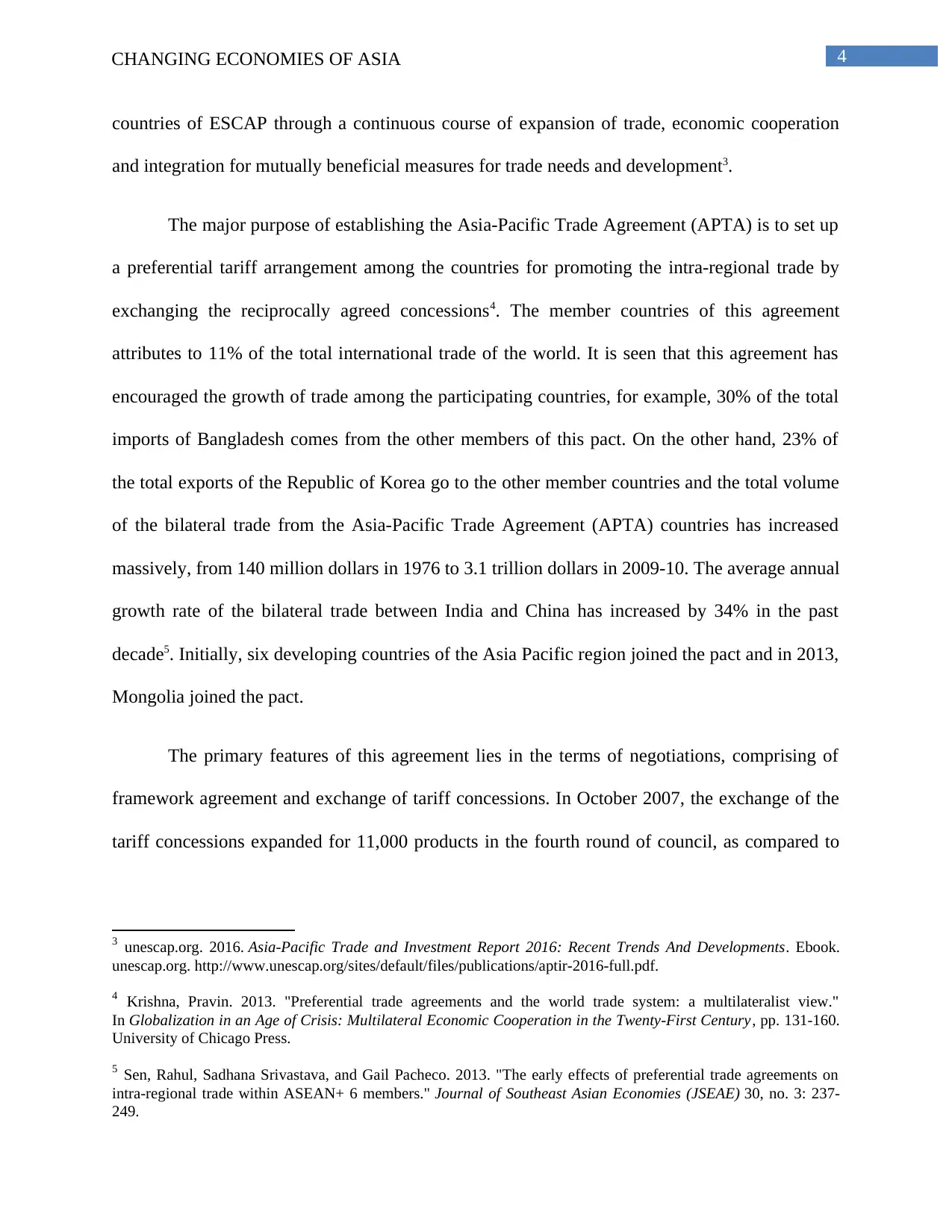
4CHANGING ECONOMIES OF ASIA
countries of ESCAP through a continuous course of expansion of trade, economic cooperation
and integration for mutually beneficial measures for trade needs and development3.
The major purpose of establishing the Asia-Pacific Trade Agreement (APTA) is to set up
a preferential tariff arrangement among the countries for promoting the intra-regional trade by
exchanging the reciprocally agreed concessions4. The member countries of this agreement
attributes to 11% of the total international trade of the world. It is seen that this agreement has
encouraged the growth of trade among the participating countries, for example, 30% of the total
imports of Bangladesh comes from the other members of this pact. On the other hand, 23% of
the total exports of the Republic of Korea go to the other member countries and the total volume
of the bilateral trade from the Asia-Pacific Trade Agreement (APTA) countries has increased
massively, from 140 million dollars in 1976 to 3.1 trillion dollars in 2009-10. The average annual
growth rate of the bilateral trade between India and China has increased by 34% in the past
decade5. Initially, six developing countries of the Asia Pacific region joined the pact and in 2013,
Mongolia joined the pact.
The primary features of this agreement lies in the terms of negotiations, comprising of
framework agreement and exchange of tariff concessions. In October 2007, the exchange of the
tariff concessions expanded for 11,000 products in the fourth round of council, as compared to
3 unescap.org. 2016. Asia-Pacific Trade and Investment Report 2016: Recent Trends And Developments. Ebook.
unescap.org. http://www.unescap.org/sites/default/files/publications/aptir-2016-full.pdf.
4 Krishna, Pravin. 2013. "Preferential trade agreements and the world trade system: a multilateralist view."
In Globalization in an Age of Crisis: Multilateral Economic Cooperation in the Twenty-First Century, pp. 131-160.
University of Chicago Press.
5 Sen, Rahul, Sadhana Srivastava, and Gail Pacheco. 2013. "The early effects of preferential trade agreements on
intra-regional trade within ASEAN+ 6 members." Journal of Southeast Asian Economies (JSEAE) 30, no. 3: 237-
249.
countries of ESCAP through a continuous course of expansion of trade, economic cooperation
and integration for mutually beneficial measures for trade needs and development3.
The major purpose of establishing the Asia-Pacific Trade Agreement (APTA) is to set up
a preferential tariff arrangement among the countries for promoting the intra-regional trade by
exchanging the reciprocally agreed concessions4. The member countries of this agreement
attributes to 11% of the total international trade of the world. It is seen that this agreement has
encouraged the growth of trade among the participating countries, for example, 30% of the total
imports of Bangladesh comes from the other members of this pact. On the other hand, 23% of
the total exports of the Republic of Korea go to the other member countries and the total volume
of the bilateral trade from the Asia-Pacific Trade Agreement (APTA) countries has increased
massively, from 140 million dollars in 1976 to 3.1 trillion dollars in 2009-10. The average annual
growth rate of the bilateral trade between India and China has increased by 34% in the past
decade5. Initially, six developing countries of the Asia Pacific region joined the pact and in 2013,
Mongolia joined the pact.
The primary features of this agreement lies in the terms of negotiations, comprising of
framework agreement and exchange of tariff concessions. In October 2007, the exchange of the
tariff concessions expanded for 11,000 products in the fourth round of council, as compared to
3 unescap.org. 2016. Asia-Pacific Trade and Investment Report 2016: Recent Trends And Developments. Ebook.
unescap.org. http://www.unescap.org/sites/default/files/publications/aptir-2016-full.pdf.
4 Krishna, Pravin. 2013. "Preferential trade agreements and the world trade system: a multilateralist view."
In Globalization in an Age of Crisis: Multilateral Economic Cooperation in the Twenty-First Century, pp. 131-160.
University of Chicago Press.
5 Sen, Rahul, Sadhana Srivastava, and Gail Pacheco. 2013. "The early effects of preferential trade agreements on
intra-regional trade within ASEAN+ 6 members." Journal of Southeast Asian Economies (JSEAE) 30, no. 3: 237-
249.
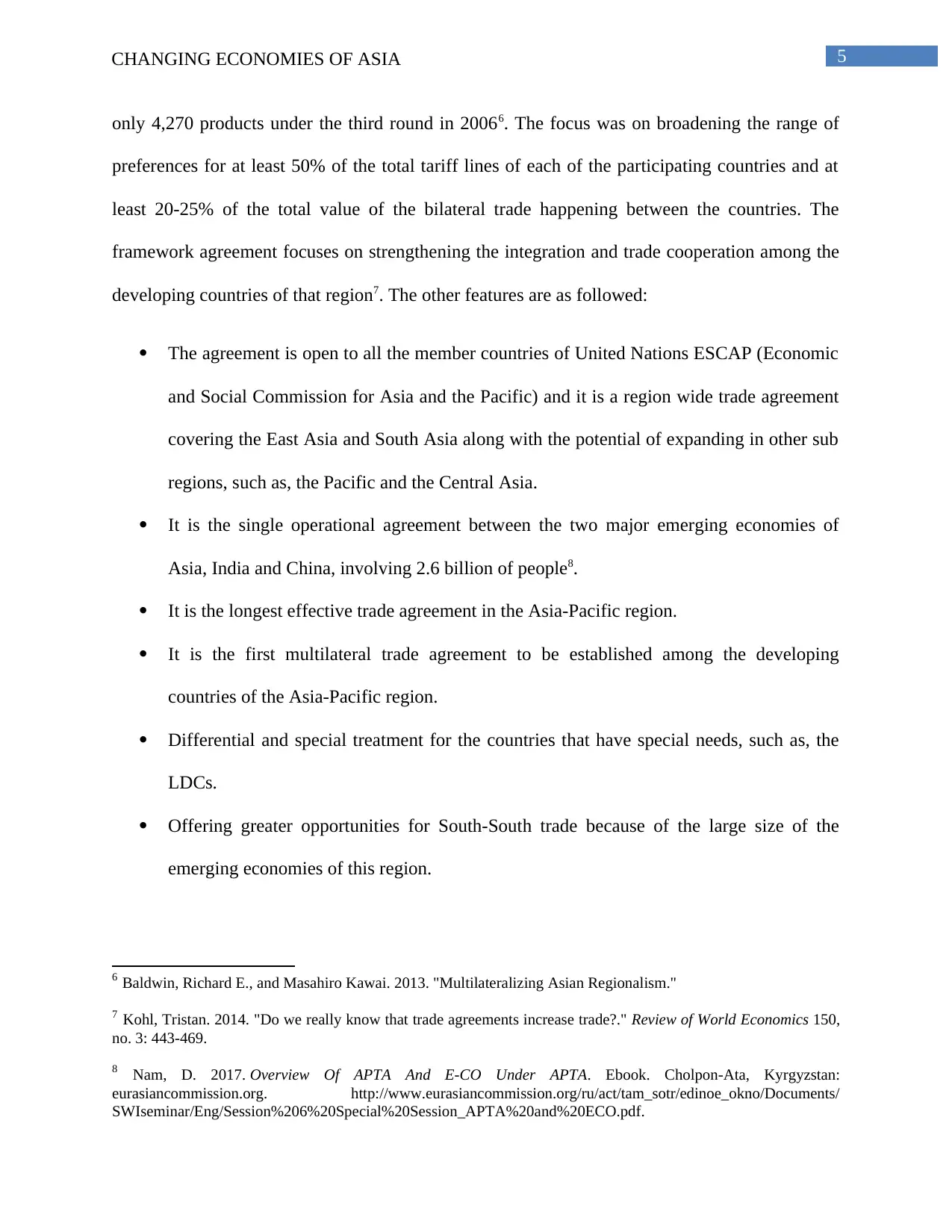
5CHANGING ECONOMIES OF ASIA
only 4,270 products under the third round in 20066. The focus was on broadening the range of
preferences for at least 50% of the total tariff lines of each of the participating countries and at
least 20-25% of the total value of the bilateral trade happening between the countries. The
framework agreement focuses on strengthening the integration and trade cooperation among the
developing countries of that region7. The other features are as followed:
The agreement is open to all the member countries of United Nations ESCAP (Economic
and Social Commission for Asia and the Pacific) and it is a region wide trade agreement
covering the East Asia and South Asia along with the potential of expanding in other sub
regions, such as, the Pacific and the Central Asia.
It is the single operational agreement between the two major emerging economies of
Asia, India and China, involving 2.6 billion of people8.
It is the longest effective trade agreement in the Asia-Pacific region.
It is the first multilateral trade agreement to be established among the developing
countries of the Asia-Pacific region.
Differential and special treatment for the countries that have special needs, such as, the
LDCs.
Offering greater opportunities for South-South trade because of the large size of the
emerging economies of this region.
6 Baldwin, Richard E., and Masahiro Kawai. 2013. "Multilateralizing Asian Regionalism."
7 Kohl, Tristan. 2014. "Do we really know that trade agreements increase trade?." Review of World Economics 150,
no. 3: 443-469.
8 Nam, D. 2017. Overview Of APTA And E-CO Under APTA. Ebook. Cholpon-Ata, Kyrgyzstan:
eurasiancommission.org. http://www.eurasiancommission.org/ru/act/tam_sotr/edinoe_okno/Documents/
SWIseminar/Eng/Session%206%20Special%20Session_APTA%20and%20ECO.pdf.
only 4,270 products under the third round in 20066. The focus was on broadening the range of
preferences for at least 50% of the total tariff lines of each of the participating countries and at
least 20-25% of the total value of the bilateral trade happening between the countries. The
framework agreement focuses on strengthening the integration and trade cooperation among the
developing countries of that region7. The other features are as followed:
The agreement is open to all the member countries of United Nations ESCAP (Economic
and Social Commission for Asia and the Pacific) and it is a region wide trade agreement
covering the East Asia and South Asia along with the potential of expanding in other sub
regions, such as, the Pacific and the Central Asia.
It is the single operational agreement between the two major emerging economies of
Asia, India and China, involving 2.6 billion of people8.
It is the longest effective trade agreement in the Asia-Pacific region.
It is the first multilateral trade agreement to be established among the developing
countries of the Asia-Pacific region.
Differential and special treatment for the countries that have special needs, such as, the
LDCs.
Offering greater opportunities for South-South trade because of the large size of the
emerging economies of this region.
6 Baldwin, Richard E., and Masahiro Kawai. 2013. "Multilateralizing Asian Regionalism."
7 Kohl, Tristan. 2014. "Do we really know that trade agreements increase trade?." Review of World Economics 150,
no. 3: 443-469.
8 Nam, D. 2017. Overview Of APTA And E-CO Under APTA. Ebook. Cholpon-Ata, Kyrgyzstan:
eurasiancommission.org. http://www.eurasiancommission.org/ru/act/tam_sotr/edinoe_okno/Documents/
SWIseminar/Eng/Session%206%20Special%20Session_APTA%20and%20ECO.pdf.

6CHANGING ECONOMIES OF ASIA
Negotiations started to focus on the services, trade facilitation, investment, products and
the non-tariff barriers among the countries from 20179.
Impact of APTA on the participating countries
APTA works as the bridge to other RTAs with direct access to the markets for the APTA
members and indirect integration with the other type of trade agreements. The share of total
amount of intra-regional APTA exports in the total exports to the world increased from 10.97%
in 2005 to 11.2% in 2013. The total volume of intra-APTA exports increased from $127 billion
in 2005 to $351 billion in 2013, which is an increase of 175%10. This indicates a huge growth of
the export market of the developing member nations. All the nations have experienced a major
growth in their domestic and international market and that contributed in the growth of their
economies. That has led to the generation of money within the economy, which in turn has
pushed up the aggregate demand and the production. The producers of these nations have
become more competitive over the years. As the level of production and trade of the entire
international economy has increased over the past few decades, the share of the APTA members
increased too. From 2005 to 2013, Lao PDR has shown the maximum level of improvement in
terms of production and export. The intra-APTA export of Lao PDR was only $25.22 million in
2005, 3.47% of the exports to the world, while it increased to $1,043.04 million in 2013, 26.17%
of the total exports to the world11.
9 Steinbock, D. 2016. "The New Trade Future In Asia Pacific – Analysis". Eurasia Review.
http://www.eurasiareview.com/28112016-the-new-trade-future-in-asia-pacific-analysis/.
10 unescap.org. 2016. Asia-Pacific Trade and Investment Report 2016: Recent Trends And Developments. Ebook.
unescap.org. http://www.unescap.org/sites/default/files/publications/aptir-2016-full.pdf.
11 Krishna, Pravin. 2013. "Preferential trade agreements and the world trade system: a multilateralist view."
In Globalization in an Age of Crisis: Multilateral Economic Cooperation in the Twenty-First Century, pp. 131-160.
Negotiations started to focus on the services, trade facilitation, investment, products and
the non-tariff barriers among the countries from 20179.
Impact of APTA on the participating countries
APTA works as the bridge to other RTAs with direct access to the markets for the APTA
members and indirect integration with the other type of trade agreements. The share of total
amount of intra-regional APTA exports in the total exports to the world increased from 10.97%
in 2005 to 11.2% in 2013. The total volume of intra-APTA exports increased from $127 billion
in 2005 to $351 billion in 2013, which is an increase of 175%10. This indicates a huge growth of
the export market of the developing member nations. All the nations have experienced a major
growth in their domestic and international market and that contributed in the growth of their
economies. That has led to the generation of money within the economy, which in turn has
pushed up the aggregate demand and the production. The producers of these nations have
become more competitive over the years. As the level of production and trade of the entire
international economy has increased over the past few decades, the share of the APTA members
increased too. From 2005 to 2013, Lao PDR has shown the maximum level of improvement in
terms of production and export. The intra-APTA export of Lao PDR was only $25.22 million in
2005, 3.47% of the exports to the world, while it increased to $1,043.04 million in 2013, 26.17%
of the total exports to the world11.
9 Steinbock, D. 2016. "The New Trade Future In Asia Pacific – Analysis". Eurasia Review.
http://www.eurasiareview.com/28112016-the-new-trade-future-in-asia-pacific-analysis/.
10 unescap.org. 2016. Asia-Pacific Trade and Investment Report 2016: Recent Trends And Developments. Ebook.
unescap.org. http://www.unescap.org/sites/default/files/publications/aptir-2016-full.pdf.
11 Krishna, Pravin. 2013. "Preferential trade agreements and the world trade system: a multilateralist view."
In Globalization in an Age of Crisis: Multilateral Economic Cooperation in the Twenty-First Century, pp. 131-160.
Paraphrase This Document
Need a fresh take? Get an instant paraphrase of this document with our AI Paraphraser
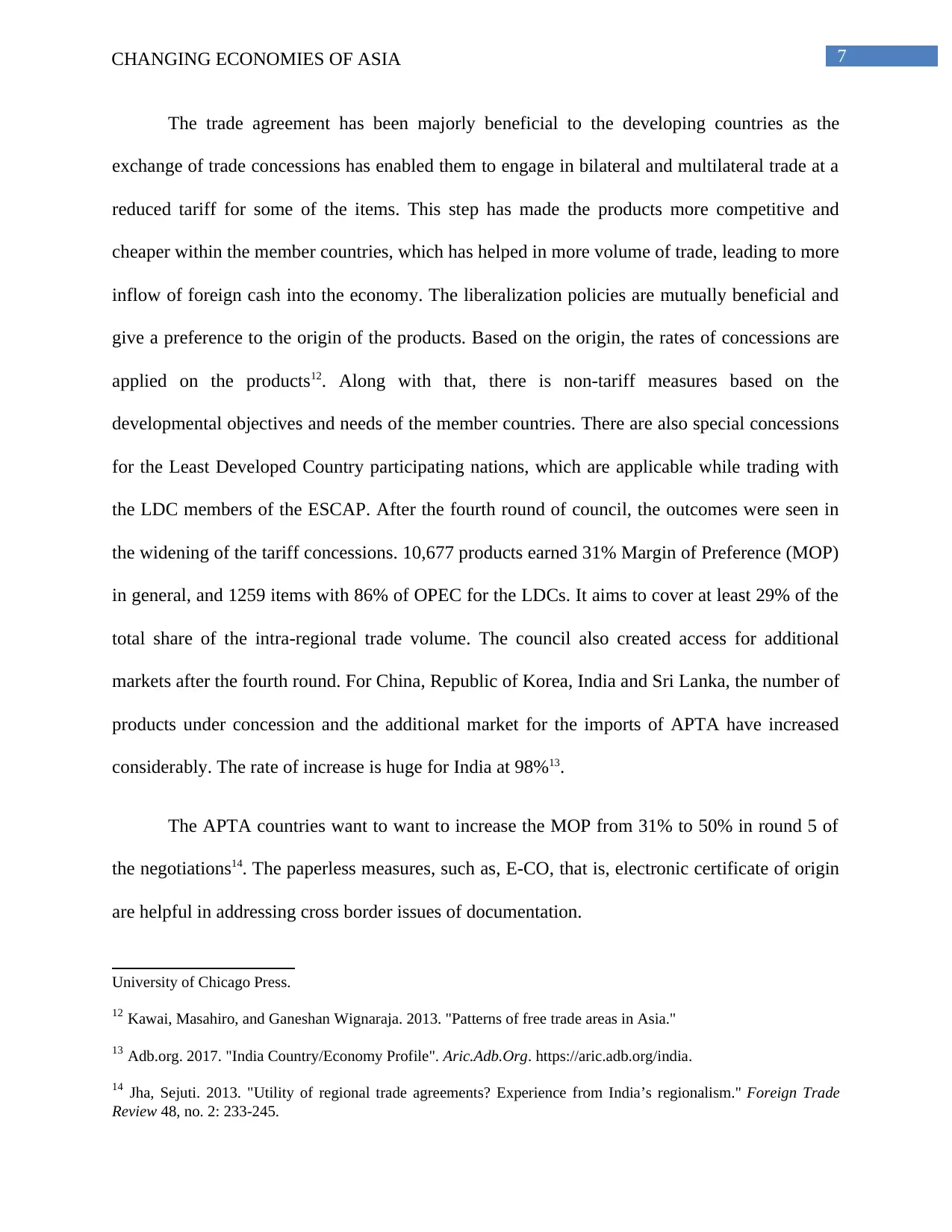
7CHANGING ECONOMIES OF ASIA
The trade agreement has been majorly beneficial to the developing countries as the
exchange of trade concessions has enabled them to engage in bilateral and multilateral trade at a
reduced tariff for some of the items. This step has made the products more competitive and
cheaper within the member countries, which has helped in more volume of trade, leading to more
inflow of foreign cash into the economy. The liberalization policies are mutually beneficial and
give a preference to the origin of the products. Based on the origin, the rates of concessions are
applied on the products12. Along with that, there is non-tariff measures based on the
developmental objectives and needs of the member countries. There are also special concessions
for the Least Developed Country participating nations, which are applicable while trading with
the LDC members of the ESCAP. After the fourth round of council, the outcomes were seen in
the widening of the tariff concessions. 10,677 products earned 31% Margin of Preference (MOP)
in general, and 1259 items with 86% of OPEC for the LDCs. It aims to cover at least 29% of the
total share of the intra-regional trade volume. The council also created access for additional
markets after the fourth round. For China, Republic of Korea, India and Sri Lanka, the number of
products under concession and the additional market for the imports of APTA have increased
considerably. The rate of increase is huge for India at 98%13.
The APTA countries want to want to increase the MOP from 31% to 50% in round 5 of
the negotiations14. The paperless measures, such as, E-CO, that is, electronic certificate of origin
are helpful in addressing cross border issues of documentation.
University of Chicago Press.
12 Kawai, Masahiro, and Ganeshan Wignaraja. 2013. "Patterns of free trade areas in Asia."
13 Adb.org. 2017. "India Country/Economy Profile". Aric.Adb.Org. https://aric.adb.org/india.
14 Jha, Sejuti. 2013. "Utility of regional trade agreements? Experience from India’s regionalism." Foreign Trade
Review 48, no. 2: 233-245.
The trade agreement has been majorly beneficial to the developing countries as the
exchange of trade concessions has enabled them to engage in bilateral and multilateral trade at a
reduced tariff for some of the items. This step has made the products more competitive and
cheaper within the member countries, which has helped in more volume of trade, leading to more
inflow of foreign cash into the economy. The liberalization policies are mutually beneficial and
give a preference to the origin of the products. Based on the origin, the rates of concessions are
applied on the products12. Along with that, there is non-tariff measures based on the
developmental objectives and needs of the member countries. There are also special concessions
for the Least Developed Country participating nations, which are applicable while trading with
the LDC members of the ESCAP. After the fourth round of council, the outcomes were seen in
the widening of the tariff concessions. 10,677 products earned 31% Margin of Preference (MOP)
in general, and 1259 items with 86% of OPEC for the LDCs. It aims to cover at least 29% of the
total share of the intra-regional trade volume. The council also created access for additional
markets after the fourth round. For China, Republic of Korea, India and Sri Lanka, the number of
products under concession and the additional market for the imports of APTA have increased
considerably. The rate of increase is huge for India at 98%13.
The APTA countries want to want to increase the MOP from 31% to 50% in round 5 of
the negotiations14. The paperless measures, such as, E-CO, that is, electronic certificate of origin
are helpful in addressing cross border issues of documentation.
University of Chicago Press.
12 Kawai, Masahiro, and Ganeshan Wignaraja. 2013. "Patterns of free trade areas in Asia."
13 Adb.org. 2017. "India Country/Economy Profile". Aric.Adb.Org. https://aric.adb.org/india.
14 Jha, Sejuti. 2013. "Utility of regional trade agreements? Experience from India’s regionalism." Foreign Trade
Review 48, no. 2: 233-245.
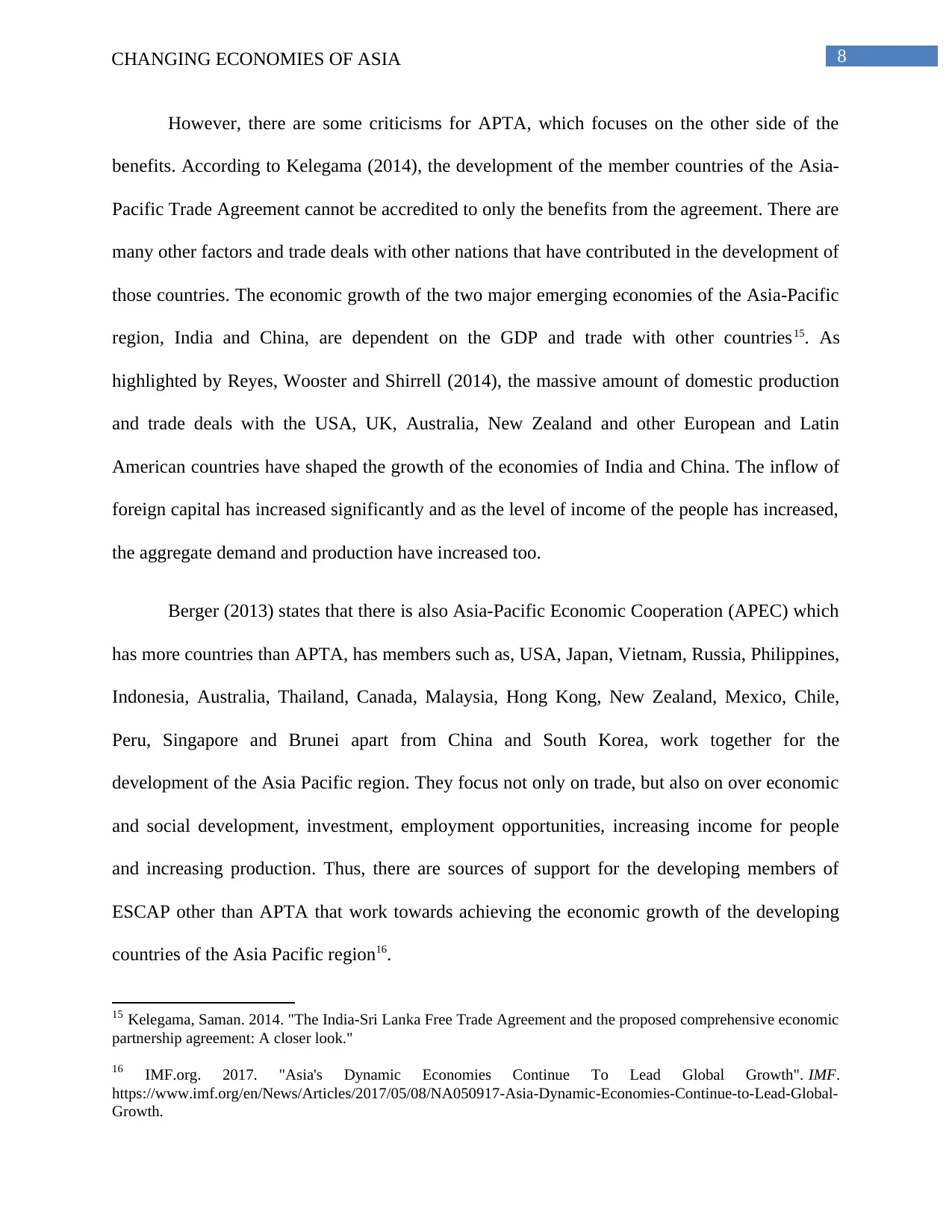
8CHANGING ECONOMIES OF ASIA
However, there are some criticisms for APTA, which focuses on the other side of the
benefits. According to Kelegama (2014), the development of the member countries of the Asia-
Pacific Trade Agreement cannot be accredited to only the benefits from the agreement. There are
many other factors and trade deals with other nations that have contributed in the development of
those countries. The economic growth of the two major emerging economies of the Asia-Pacific
region, India and China, are dependent on the GDP and trade with other countries15. As
highlighted by Reyes, Wooster and Shirrell (2014), the massive amount of domestic production
and trade deals with the USA, UK, Australia, New Zealand and other European and Latin
American countries have shaped the growth of the economies of India and China. The inflow of
foreign capital has increased significantly and as the level of income of the people has increased,
the aggregate demand and production have increased too.
Berger (2013) states that there is also Asia-Pacific Economic Cooperation (APEC) which
has more countries than APTA, has members such as, USA, Japan, Vietnam, Russia, Philippines,
Indonesia, Australia, Thailand, Canada, Malaysia, Hong Kong, New Zealand, Mexico, Chile,
Peru, Singapore and Brunei apart from China and South Korea, work together for the
development of the Asia Pacific region. They focus not only on trade, but also on over economic
and social development, investment, employment opportunities, increasing income for people
and increasing production. Thus, there are sources of support for the developing members of
ESCAP other than APTA that work towards achieving the economic growth of the developing
countries of the Asia Pacific region16.
15 Kelegama, Saman. 2014. "The India-Sri Lanka Free Trade Agreement and the proposed comprehensive economic
partnership agreement: A closer look."
16 IMF.org. 2017. "Asia's Dynamic Economies Continue To Lead Global Growth". IMF.
https://www.imf.org/en/News/Articles/2017/05/08/NA050917-Asia-Dynamic-Economies-Continue-to-Lead-Global-
Growth.
However, there are some criticisms for APTA, which focuses on the other side of the
benefits. According to Kelegama (2014), the development of the member countries of the Asia-
Pacific Trade Agreement cannot be accredited to only the benefits from the agreement. There are
many other factors and trade deals with other nations that have contributed in the development of
those countries. The economic growth of the two major emerging economies of the Asia-Pacific
region, India and China, are dependent on the GDP and trade with other countries15. As
highlighted by Reyes, Wooster and Shirrell (2014), the massive amount of domestic production
and trade deals with the USA, UK, Australia, New Zealand and other European and Latin
American countries have shaped the growth of the economies of India and China. The inflow of
foreign capital has increased significantly and as the level of income of the people has increased,
the aggregate demand and production have increased too.
Berger (2013) states that there is also Asia-Pacific Economic Cooperation (APEC) which
has more countries than APTA, has members such as, USA, Japan, Vietnam, Russia, Philippines,
Indonesia, Australia, Thailand, Canada, Malaysia, Hong Kong, New Zealand, Mexico, Chile,
Peru, Singapore and Brunei apart from China and South Korea, work together for the
development of the Asia Pacific region. They focus not only on trade, but also on over economic
and social development, investment, employment opportunities, increasing income for people
and increasing production. Thus, there are sources of support for the developing members of
ESCAP other than APTA that work towards achieving the economic growth of the developing
countries of the Asia Pacific region16.
15 Kelegama, Saman. 2014. "The India-Sri Lanka Free Trade Agreement and the proposed comprehensive economic
partnership agreement: A closer look."
16 IMF.org. 2017. "Asia's Dynamic Economies Continue To Lead Global Growth". IMF.
https://www.imf.org/en/News/Articles/2017/05/08/NA050917-Asia-Dynamic-Economies-Continue-to-Lead-Global-
Growth.
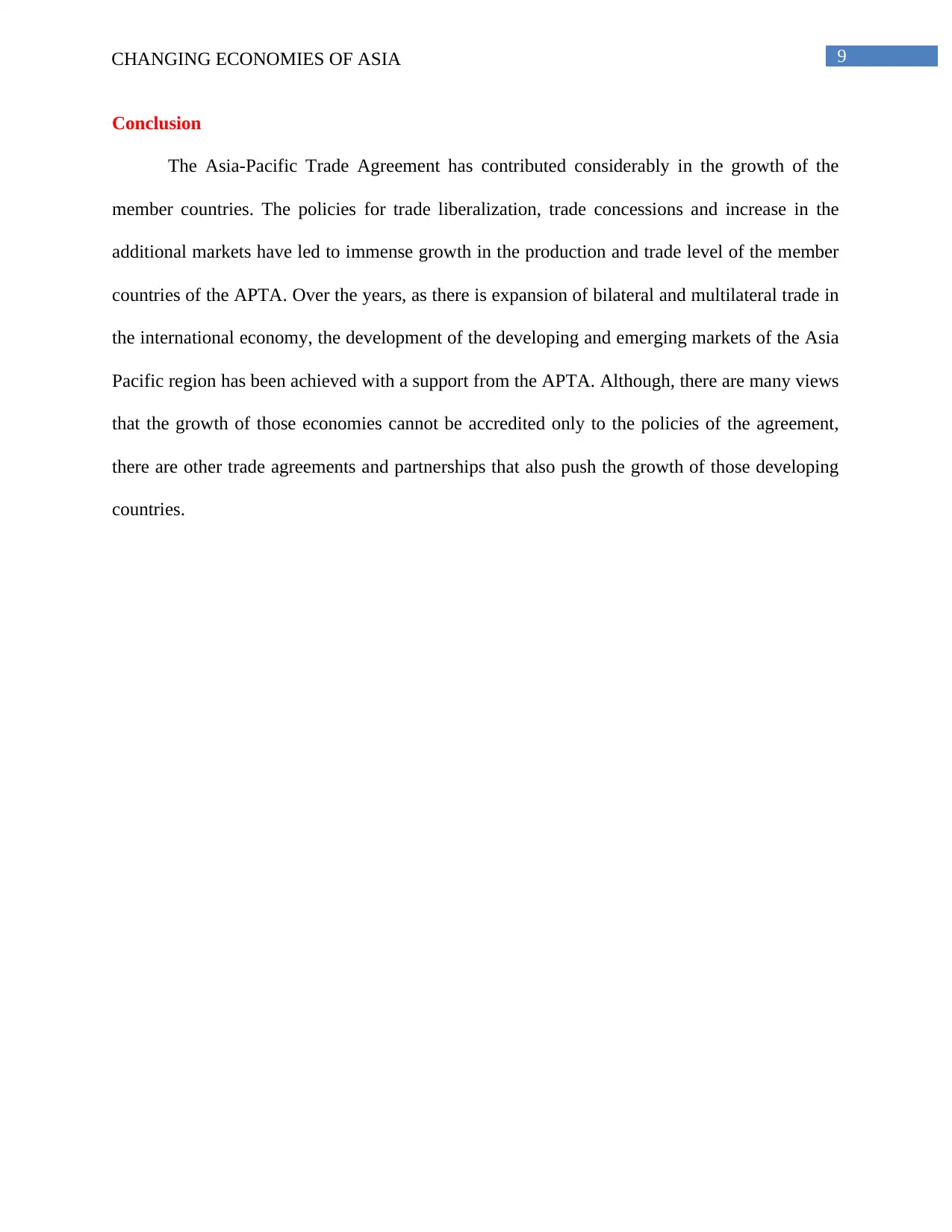
9CHANGING ECONOMIES OF ASIA
Conclusion
The Asia-Pacific Trade Agreement has contributed considerably in the growth of the
member countries. The policies for trade liberalization, trade concessions and increase in the
additional markets have led to immense growth in the production and trade level of the member
countries of the APTA. Over the years, as there is expansion of bilateral and multilateral trade in
the international economy, the development of the developing and emerging markets of the Asia
Pacific region has been achieved with a support from the APTA. Although, there are many views
that the growth of those economies cannot be accredited only to the policies of the agreement,
there are other trade agreements and partnerships that also push the growth of those developing
countries.
Conclusion
The Asia-Pacific Trade Agreement has contributed considerably in the growth of the
member countries. The policies for trade liberalization, trade concessions and increase in the
additional markets have led to immense growth in the production and trade level of the member
countries of the APTA. Over the years, as there is expansion of bilateral and multilateral trade in
the international economy, the development of the developing and emerging markets of the Asia
Pacific region has been achieved with a support from the APTA. Although, there are many views
that the growth of those economies cannot be accredited only to the policies of the agreement,
there are other trade agreements and partnerships that also push the growth of those developing
countries.
Secure Best Marks with AI Grader
Need help grading? Try our AI Grader for instant feedback on your assignments.
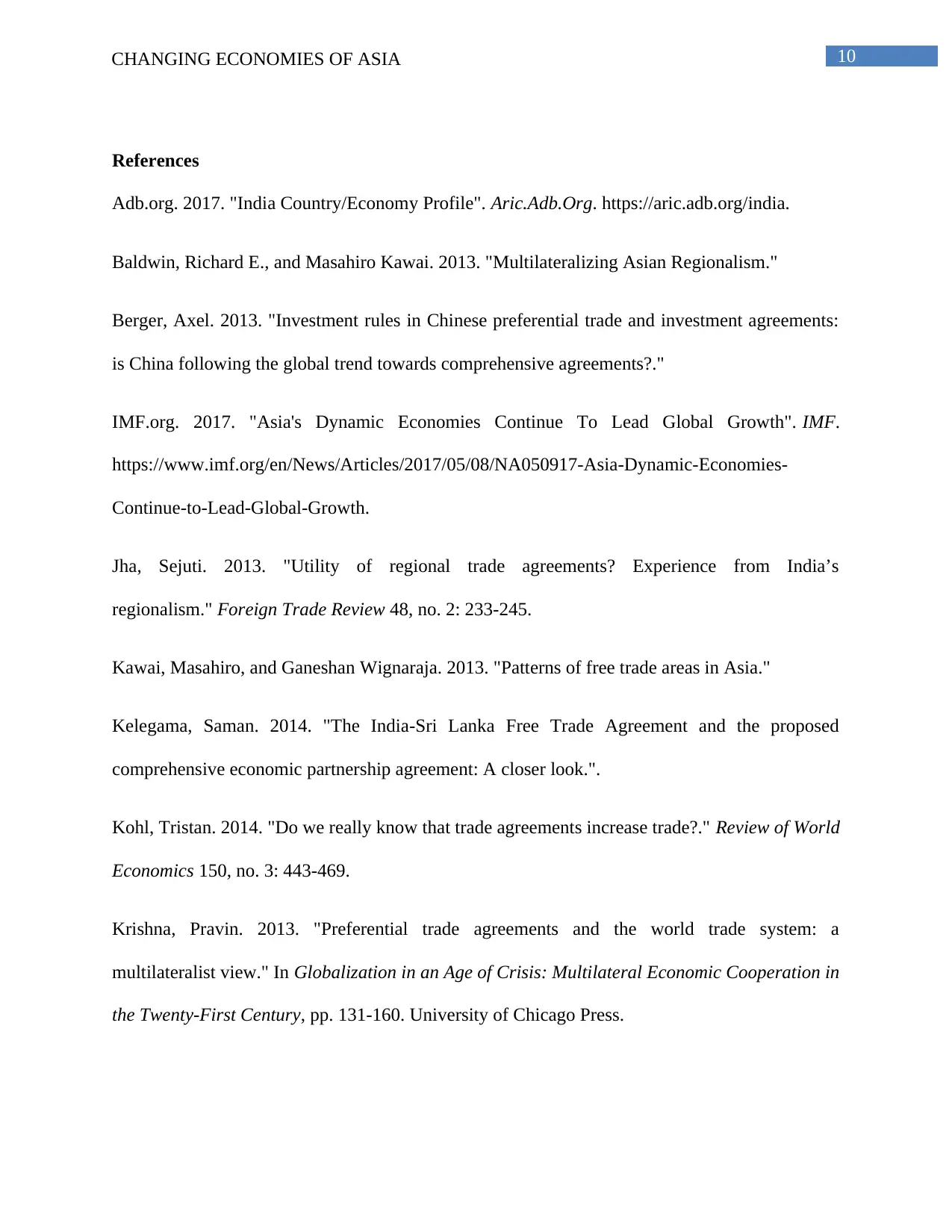
10CHANGING ECONOMIES OF ASIA
References
Adb.org. 2017. "India Country/Economy Profile". Aric.Adb.Org. https://aric.adb.org/india.
Baldwin, Richard E., and Masahiro Kawai. 2013. "Multilateralizing Asian Regionalism."
Berger, Axel. 2013. "Investment rules in Chinese preferential trade and investment agreements:
is China following the global trend towards comprehensive agreements?."
IMF.org. 2017. "Asia's Dynamic Economies Continue To Lead Global Growth". IMF.
https://www.imf.org/en/News/Articles/2017/05/08/NA050917-Asia-Dynamic-Economies-
Continue-to-Lead-Global-Growth.
Jha, Sejuti. 2013. "Utility of regional trade agreements? Experience from India’s
regionalism." Foreign Trade Review 48, no. 2: 233-245.
Kawai, Masahiro, and Ganeshan Wignaraja. 2013. "Patterns of free trade areas in Asia."
Kelegama, Saman. 2014. "The India-Sri Lanka Free Trade Agreement and the proposed
comprehensive economic partnership agreement: A closer look.".
Kohl, Tristan. 2014. "Do we really know that trade agreements increase trade?." Review of World
Economics 150, no. 3: 443-469.
Krishna, Pravin. 2013. "Preferential trade agreements and the world trade system: a
multilateralist view." In Globalization in an Age of Crisis: Multilateral Economic Cooperation in
the Twenty-First Century, pp. 131-160. University of Chicago Press.
References
Adb.org. 2017. "India Country/Economy Profile". Aric.Adb.Org. https://aric.adb.org/india.
Baldwin, Richard E., and Masahiro Kawai. 2013. "Multilateralizing Asian Regionalism."
Berger, Axel. 2013. "Investment rules in Chinese preferential trade and investment agreements:
is China following the global trend towards comprehensive agreements?."
IMF.org. 2017. "Asia's Dynamic Economies Continue To Lead Global Growth". IMF.
https://www.imf.org/en/News/Articles/2017/05/08/NA050917-Asia-Dynamic-Economies-
Continue-to-Lead-Global-Growth.
Jha, Sejuti. 2013. "Utility of regional trade agreements? Experience from India’s
regionalism." Foreign Trade Review 48, no. 2: 233-245.
Kawai, Masahiro, and Ganeshan Wignaraja. 2013. "Patterns of free trade areas in Asia."
Kelegama, Saman. 2014. "The India-Sri Lanka Free Trade Agreement and the proposed
comprehensive economic partnership agreement: A closer look.".
Kohl, Tristan. 2014. "Do we really know that trade agreements increase trade?." Review of World
Economics 150, no. 3: 443-469.
Krishna, Pravin. 2013. "Preferential trade agreements and the world trade system: a
multilateralist view." In Globalization in an Age of Crisis: Multilateral Economic Cooperation in
the Twenty-First Century, pp. 131-160. University of Chicago Press.
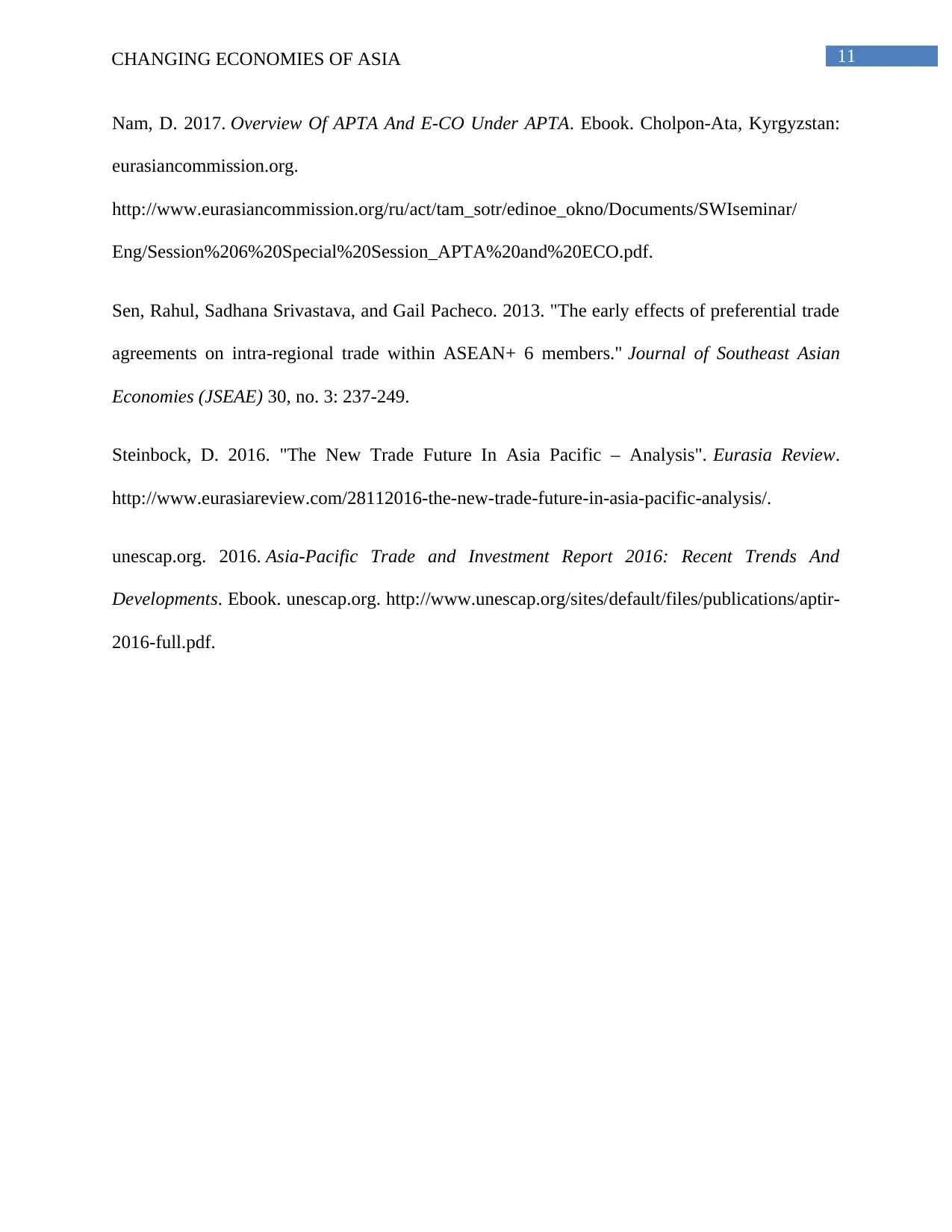
11CHANGING ECONOMIES OF ASIA
Nam, D. 2017. Overview Of APTA And E-CO Under APTA. Ebook. Cholpon-Ata, Kyrgyzstan:
eurasiancommission.org.
http://www.eurasiancommission.org/ru/act/tam_sotr/edinoe_okno/Documents/SWIseminar/
Eng/Session%206%20Special%20Session_APTA%20and%20ECO.pdf.
Sen, Rahul, Sadhana Srivastava, and Gail Pacheco. 2013. "The early effects of preferential trade
agreements on intra-regional trade within ASEAN+ 6 members." Journal of Southeast Asian
Economies (JSEAE) 30, no. 3: 237-249.
Steinbock, D. 2016. "The New Trade Future In Asia Pacific – Analysis". Eurasia Review.
http://www.eurasiareview.com/28112016-the-new-trade-future-in-asia-pacific-analysis/.
unescap.org. 2016. Asia-Pacific Trade and Investment Report 2016: Recent Trends And
Developments. Ebook. unescap.org. http://www.unescap.org/sites/default/files/publications/aptir-
2016-full.pdf.
Nam, D. 2017. Overview Of APTA And E-CO Under APTA. Ebook. Cholpon-Ata, Kyrgyzstan:
eurasiancommission.org.
http://www.eurasiancommission.org/ru/act/tam_sotr/edinoe_okno/Documents/SWIseminar/
Eng/Session%206%20Special%20Session_APTA%20and%20ECO.pdf.
Sen, Rahul, Sadhana Srivastava, and Gail Pacheco. 2013. "The early effects of preferential trade
agreements on intra-regional trade within ASEAN+ 6 members." Journal of Southeast Asian
Economies (JSEAE) 30, no. 3: 237-249.
Steinbock, D. 2016. "The New Trade Future In Asia Pacific – Analysis". Eurasia Review.
http://www.eurasiareview.com/28112016-the-new-trade-future-in-asia-pacific-analysis/.
unescap.org. 2016. Asia-Pacific Trade and Investment Report 2016: Recent Trends And
Developments. Ebook. unescap.org. http://www.unescap.org/sites/default/files/publications/aptir-
2016-full.pdf.
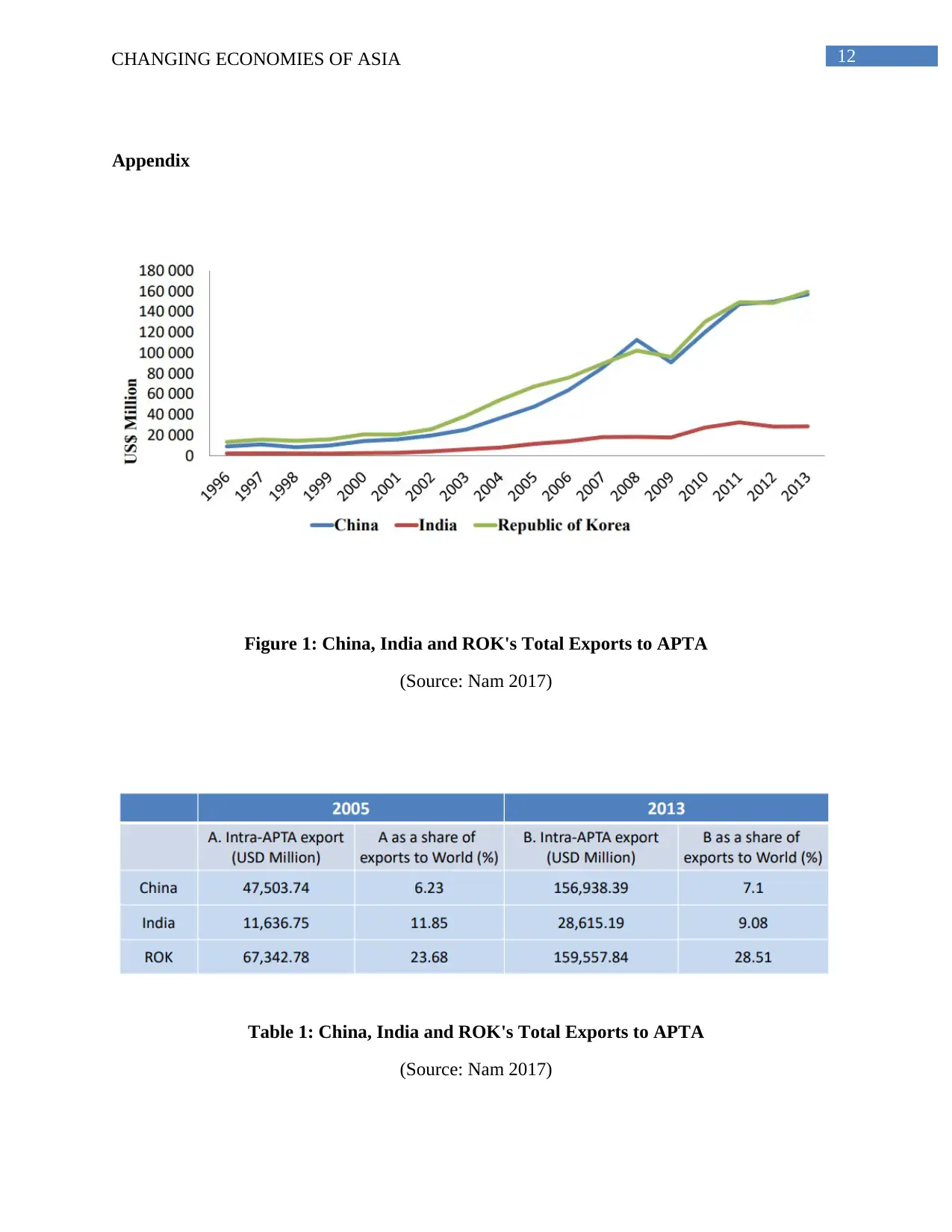
12CHANGING ECONOMIES OF ASIA
Appendix
Figure 1: China, India and ROK's Total Exports to APTA
(Source: Nam 2017)
Table 1: China, India and ROK's Total Exports to APTA
(Source: Nam 2017)
Appendix
Figure 1: China, India and ROK's Total Exports to APTA
(Source: Nam 2017)
Table 1: China, India and ROK's Total Exports to APTA
(Source: Nam 2017)
Paraphrase This Document
Need a fresh take? Get an instant paraphrase of this document with our AI Paraphraser
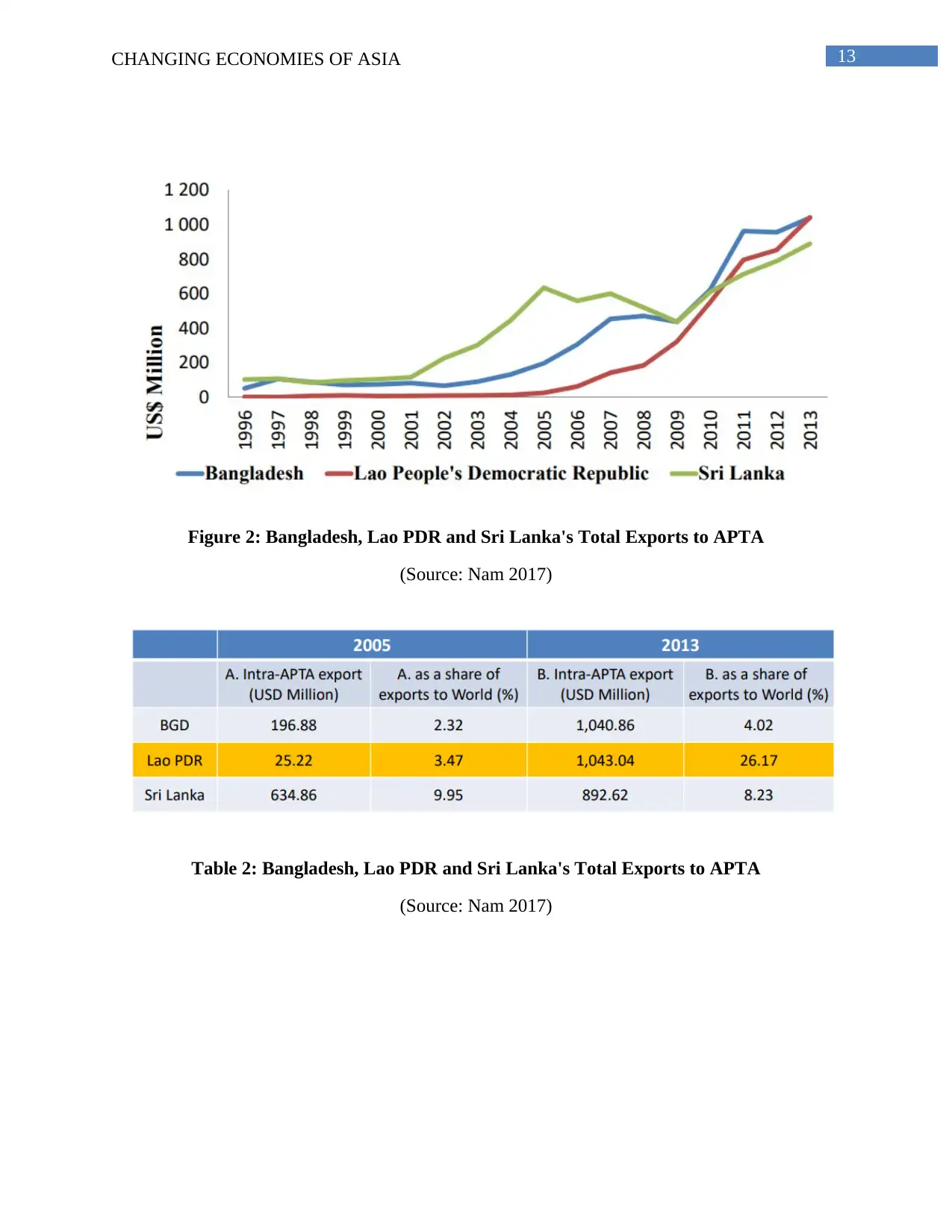
13CHANGING ECONOMIES OF ASIA
Figure 2: Bangladesh, Lao PDR and Sri Lanka's Total Exports to APTA
(Source: Nam 2017)
Table 2: Bangladesh, Lao PDR and Sri Lanka's Total Exports to APTA
(Source: Nam 2017)
Figure 2: Bangladesh, Lao PDR and Sri Lanka's Total Exports to APTA
(Source: Nam 2017)
Table 2: Bangladesh, Lao PDR and Sri Lanka's Total Exports to APTA
(Source: Nam 2017)
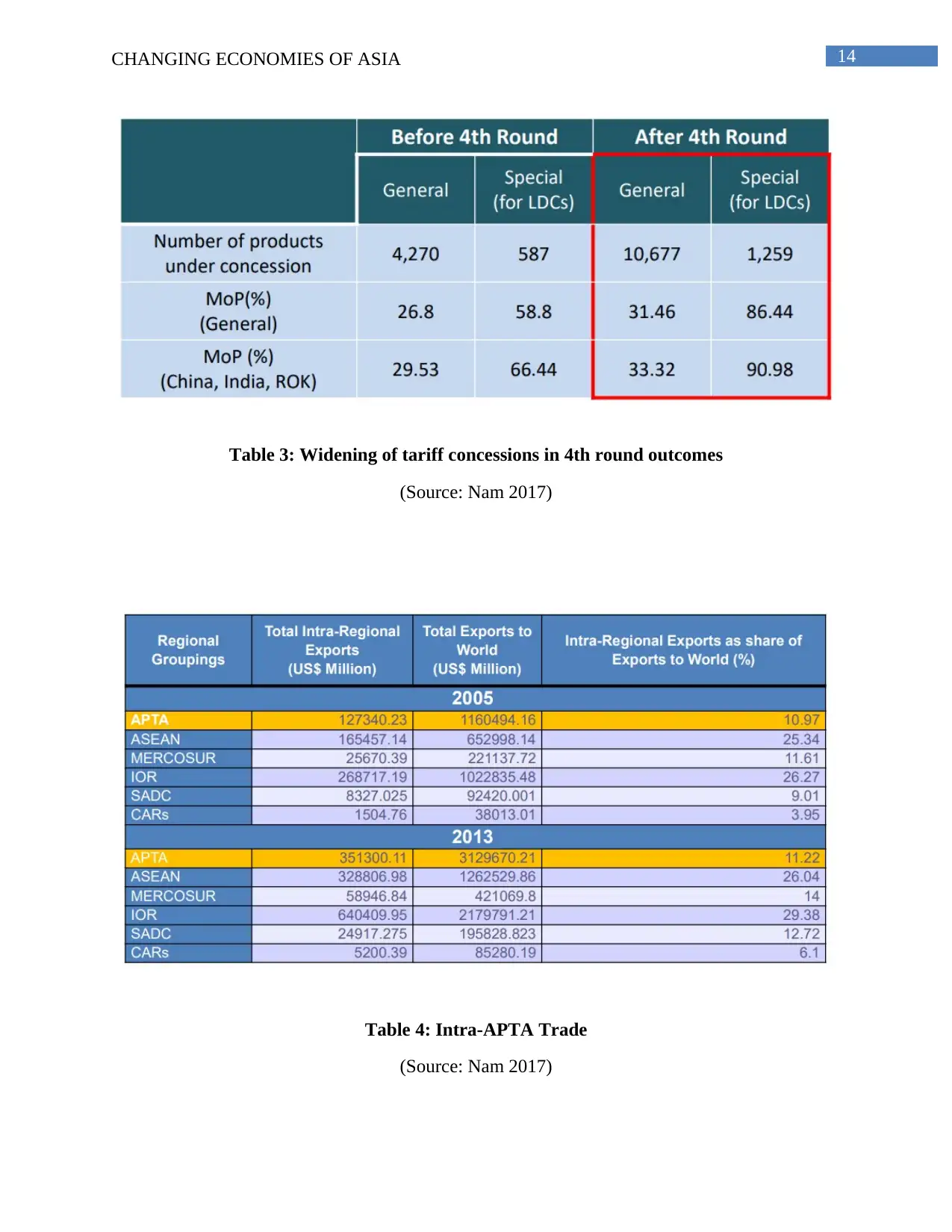
14CHANGING ECONOMIES OF ASIA
Table 3: Widening of tariff concessions in 4th round outcomes
(Source: Nam 2017)
Table 4: Intra-APTA Trade
(Source: Nam 2017)
Table 3: Widening of tariff concessions in 4th round outcomes
(Source: Nam 2017)
Table 4: Intra-APTA Trade
(Source: Nam 2017)
1 out of 15
Your All-in-One AI-Powered Toolkit for Academic Success.
+13062052269
info@desklib.com
Available 24*7 on WhatsApp / Email
![[object Object]](/_next/static/media/star-bottom.7253800d.svg)
Unlock your academic potential
© 2024 | Zucol Services PVT LTD | All rights reserved.

